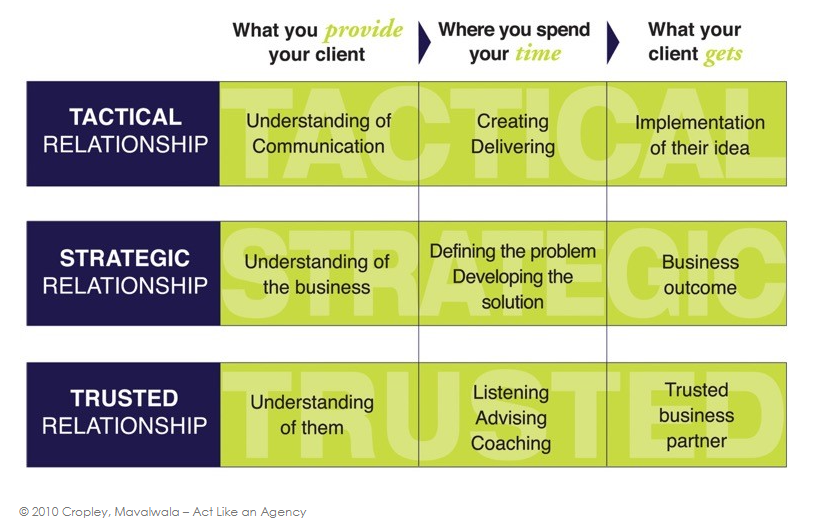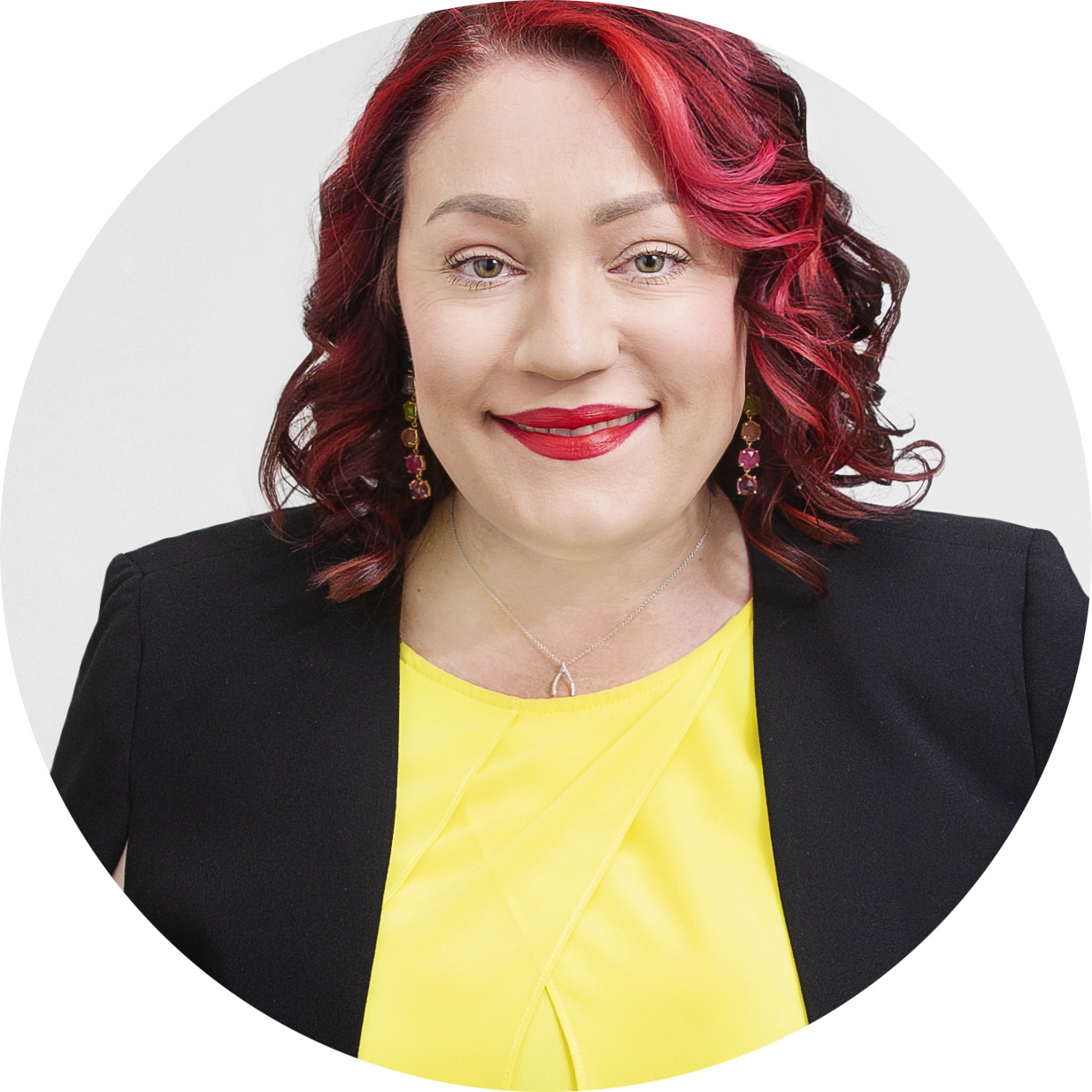Author and un-marketing expert Scott Stratten says: “If you believe business is built on relationships, make building them your business.”
While maintaining effective relationships is important in an organisation, there are certain relationships that deserve extra attention, especially for communication professionals – and particularly if they want to influence the C-suite.
What kind of relationship do you think you have with your internal business partners or leaders? Would they describe you or your communication colleagues the same way you do? Do you have the credibility to sell your ideas to the people that make the decisions? Have you found time to strategically position yourself to the people who matter most in your organisation?
This is the client relationship model I use when I run training through the Centre for Strategic Communication Excellence, teaching communication professionals how to evolve from tacticians to strategists.
The model describes three types of relationship you might have with your internal business partners or leaders.

Let’s take a closer look at each type of relationship.
Tactical relationship
In a tactical relationship, people are likely to see you as a communication expert. They might come to you with a request for a communication output such as a newsletter or an email. Your time is spent creating and delivering the things they asked for. What they get from you is a communication output. They are likely to judge success on factors such as whether you produced it on time and to budget, whether it looks good, and perhaps whether people liked it or read it.
Strategic relationship
In a strategic relationship, people see you as someone who can use communication to help them address a business need or solve an organisational problem. They see you as a communication expert but also, importantly, a business person just like they are. You’ll be focusing on the same business issues and goals, but you each have different types of expertise you can call on to deliver those goals. In this type of relationship, you’re likely to spend your time understanding their issue, helping them define the problem they want to solve, and determining what they need to know, feel and do to resolve it. What they get from you is a business outcome – help solving the problem they came to you with. Ultimately, you should be able to measure the success of your work through the impact you had on business results.
Trusted relationship
In a trusted relationship, people see you as someone they can talk to and they trust and respect your opinion, even when you challenge their approach if you believe it’s in the best interests of the business. You understand their issues and you also understand them as a person. In this type of relationship, you’re likely to spend much of your time listening, advising and coaching. In this way, over time, you also build your business partners’ and leaders’ communication competence. What they get from you is a genuine business partner.
These relationships are not necessarily mutually exclusive, and each level gets progressively harder to measure and achieve. You could, for example, have a strategic relationship with someone as well as a trusted one. Your interactions with the same person may also vary. For instance, your CEO may trust and respect your advice, but they may also ask you to draft the occasional email for them.
Many communication professionals say they want to be consultants and coaches. But it’s easier to focus on outputs such as the number of web hits than try and pin down exactly what role your communication played in reducing say, safety incidents. It also might feel like a bigger achievement to be able to report that you delivered a great leadership meeting to the top 120 senior executives, instead of saying that you had an insightful conversation with one of your business partners or leaders this week.
Here's an example of the three types of relationship in action:
The CEO has asked you to design a PowerPoint presentation on the organisation’s annual performance to share with employees via email:
- In a tactical relationship you would take note of delivery details, audience and key messages and get to work.
- In a strategic relationship you might ask the CEO a series of questions to determine the business drivers and outcome, so you could produce a presentation that highlighted the role employees played in business success.
- In a trusted relationship you might challenge the CEO to participate in a roadshow to thank employees personally for their part in the organisation’s success, instead of emailing them the results. You might also remind them of your organisation’s latest employee engagement results and how you scored against leadership visibility and recognition. Of course, if you had a trusted relationship with your CEO, they wouldn’t have asked you to design a PowerPoint presentation in the first place – they would have asked you for your opinion on the best way to present the results to your employees, or you would have made the suggestion long before they asked you.
So, what practical steps can you take to build more strategic and trusted relationships with your business partners and leaders?
1. Ensure business needs drive communication outcomes
The first and most important step to developing more strategic relationships within your organisation is to clearly understand your organisation’s needs and align your communication with its mission, vision and values. What is the business trying to achieve? For example, if leadership visibility is a problem acknowledge that with research, facts, and data that demonstrate the issue. This information typically exists in your organisation’s strategic plans, or you might find your data in any business initiative. The second part of this important step is to match the needs of the business with the communication opportunity. How can communication make a difference? Resist the temptation to move straight to a solution. Ensure you’re delivering communication that addresses the business strategy not because it’s a nice thing to do.
2. Ask the right questions
Start to uncover the real business issues affecting your organisation and what keeps your internal clients awake at night. By having a conversation, you help to set the context that you are discussing business, not your communication and that will help people to think of you as a partner, not a supplier.
Your questions should focus on:
- why your client has come to you (the business issue not the tactic they may have asked for)
- what success looks like and what people should be doing differently because of your communication
- your audience and their habits, behaviours and demographics
- what timeframe you have to fit this into your planning
- the roadblocks that may prevent you from achieving expected outcomes
- any potential financial savings
- how your client sees themselves involved.
3. Harness information and opportunities
You need to have a robust understanding of the global communication profession, industry trends and drivers. But an appreciation of the external context, research and trends isn’t enough.
You should also:
- incorporate internal trends in your communication work, for example, look out for the organisational issues that keep coming up and use the insights to inform your work
- connect with your internal and external peers to discuss and share observations about the communication profession and market
- understand and define the impact your communication has on your organisation’s strategy.
Do this well and your communication efforts will drive business results, build your reputation and earn you the role of trusted advisor and business partner within your organisation.
About the Author
Sia Papageorgiou is a multi-award-winning strategic communication leader on a mission to elevate the value and visibility of communication professionals and help them become trusted, strategic, and in-demand advisors. She’s worked with some of the wo...


